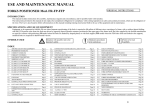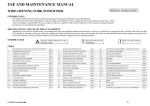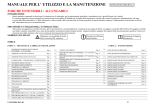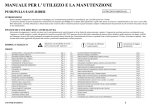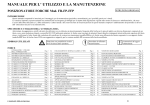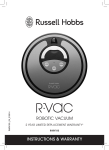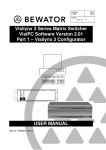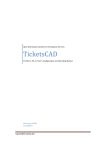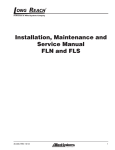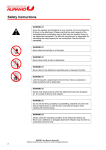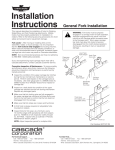Download Service Manual
Transcript
USE AND MAINTENANCE MANUAL ORIGINAL INSTRUCTIONS CLAMP 1-2 PALLETS INTRODUCTION This manual includes instructions for assembly, maintenance (regular and extraordinary), and for possible faults with remedies. The instructions in this manual do not replace but supplement the obligations for complying with current safety and accident prevention regulations, that are the user company's responsibility. The User is also bound to follow all instructions in this manual including training of personnel both in the use of the equipment and its maintenance. SPECIFICATIONS AND USE OF EQUIPMENT Equipment to be attached to forklifts, for the handling, approach, removal and transportation of 1-2 loads placed on pallets. Consisting of a base frame with fork support guide shoes, complete with hooks with ISO 2328 profile for attachment to the forklift or with semi-incorporated side-shifting; hydraulic system with valve for the synchronised opening-closing of the forks; forks, suitable for introduction into the pallet, bolted to supports driven by hydraulic linear actuators. SYMBOLS USED Situation with possible risk to the operator's safety. Mandatory procedures to be carried out. Notes to be read carefully. INDEX 1. TIPS FOR USE OF THE EQUIPMENT Page 2 4.4. HOSES CONNECTION Page 7 9.7. 1.1. PROHIBITED HANDLING Page 2 4.4.1. WITHOUT SIDE-SHIFTING Page 7 9.7.1. REMOVAL OF CYLINDERS AND REPLACEMENT OF SEALS Page 11 1.2. MANOEUVRES THAT COMPROMISE STABILITY Page 2 OR VISIBILITY 4.4.2. WITH SIDE-SHIFTING Page 7 9.7.2. STEM SIDE CYLINDER ASSEMBLY Page 12 1.3. CORRECT HANDLING 5. HYDRAULIC SYSTEM Page 7 9.7.3. BULKHEAD SIDE CYLINDER ASSEMBLY Page 12 CONNECTION AND LAYOUT WITHOUT SIDE-SHIFTING Page 7 9.8. Page 12 Page 7 9.8.1. DETACHMENT FROM THE FORKLIFT Page 12 Page 8 9.8.2. VALVE DETACHMENT Page 12 Page 13 Page 3 1.4. PALLETS APPROACH Page 3 5.1. 1.5. PALLETS RETREAT Page 3 5.1.1. CONTROL OF MOVEMENTS CONNECTION AND LAYOUT WITH SIDESHIFTING CYLINDER MAINTENANCE Page 11 REMOVAL OF FLOW DIVIDER 2. FORKLIFT CONTROLS Page 3 5.2. 3. EQUIPMENT DESCRIPTION Page 4 5.2.1. CONTROL OF CONNECTIONS Page 8 9.9. 3.1. SHIPPING LAYOUT Page 4 6. ADJUSTMENTS AND CONTROLS Page 8 9.9.1. DISASSEMBLY OF SHOES AND CYLINDER SIDE-SHIFT MAINTENANCE Page 13 3.2. DESCRIPTION Page 4 7. DAILY CONTROLS Page 8 9.9.2. SHOES CONTROL Page 13 4. FASTENING TO THE FORKLIFT Page 6 8. ROUTINE MAINTENANCE Page 9 9.9.3. REPLACEMENT OF SEALS Page 13 4.1. COUPLING Page 6 9. EXTRAORDINARY MAINTENANCE Page 10 10. VERSIONS FOR FORK ALIGNMENT Page 14 4.2. FIXING OF LOWER HOOKS Page 6 9.1. FORKS DISASSEMBLY Page 10 11. LIST OF POSSIBLE FAULTS WITH CAUSES AND REMEDIES Page 15 4.2.1. WITH SIDE-SHIFTING Page 6 9.2. SUPPORTS DISASSEMBLY Page 10 12. NOISE EMISSION 4.2.2. WITHOUT SIDE-SHIFTING Page 6 9.3. FRAME SHOES DISASSEMBLY Page 10 13. RECYCLING Page 15 4.3. Page 6 9.4. SUPPORTS SHOES DISASSEMBLY Page 11 14. WARRANTY Page 15 4.3.1. WITH SIDE-SHIFTING Page 6 9.5. FRAME SHOES CONTROL Page 11 15. FACSIMILE OF THE EC CONFORMITY CERTIFICATE Page 15 4.3.2. WITHOUT SIDE-SHIFTING Page 6 9.6. SUPPORT SHOES REPLACEMENT Page 11 LOWER HOOKS REPOSITIONING UM-BIP-04-2010-R2 Page 15 1 USE AND MAINTENANCE MANUAL 1. ADVICE FOR THE EQUIPMENT'S USE USE OF THE EQUIPMENT FOR PURPOSES OR HANDLING DIFFERENT FROM THAT INDICATED IS PROHIBITED. 1.1. PROHIBITED HANDLING THE EFFECTIVE COMBINATION CARRYING CAPACITY BETWEEN THE FORKLIFT TRUCK AND THE EQUIPMENT IS THE RESPONSIBILITY OF THE FORKLIFT TRUCK MANUFACTURER AND MAY NOT CORRESPOND TO THAT INDICATED ON THE RATING PLATE. 1.2. MANOEUVRES THAT COMPROMISE STABILITY OR VISIBILITY Lifting a single load on the side forks. Lifting 2 stacked loads. Transporting a load that is unstable or off-centre; too bulky reducing visibility; with a weight greater than the specified lifting capacity; move a load already deposited using the load to be deposited; using the equipment when structurally defective or malfunctioning. Lifting 4 loads at the same time. Lifting 3 loads one of which on one side. Performing movements or manoeuvres with the load lifted high. Proceeding at high speed in the presence of the uneven ground or uphill ramps. Parking the forklift truck with the engine running and/or load lifted on uneven ground or ramps. Transporting persons or performing manoeuvres with people within operating action of the forklift. UM-BIP-04-2010-R2 2 USE AND MAINTENANCE MANUAL 1.3. CORRECT HANDLING Pay attention when picking up the pallet to avoid damage or hazardous movements of adjacent loads. The load must be stable, in crossed layers or secured by straps. 1.4. PALLETS APPROACH For the approach: fully open the equipment, insert the forks and lift the load, approach the pallets and deposit them on the floor. Repeat the manoeuvre until the desired position is achieved. 2. CONTROLS ON THE FORKLIFT The hydraulic pump of the forklift, controlled by the distributor, must have a max. pressure of 18 MPa and a capacity of 25 - 30 l/m’. The recommended inner diameter for any additional supply system is at least 9.5 mm. 4-lever distributor for movements control. When moving with the forklift truck, keep the mast tilted (the tip of the fork up), the load slightly off the ground and centred, adjusting the speed according to the state of the road surface and any obstacles or presence of people along the route. 1.5. PALLETS RETREAT Before lifting, ensure that the external forks are correctly inserted into the pallet. Handle loads with a height no greater than the grid of the equipment so as not to undermine visibility during manoeuvres. The tips of the forks should rest on the last cross member of the pallet without protruding from it. The fork positioning slots must be intact and not clogged. The fork carriage must be flat without protrusions on the front. For the retreat: insert the forks into the pallet and close the clamp until the external fork is in contact with the pallet. Lift the load and fully open the clamp and deposit on the ground. Repeat the manoeuvre until the desired position is achieved. Dimension « A » ISO 2328 (mm) : Class I = min. 304 – max. 305 Class II = min. 380 - max. 381 Class III = min. 474.5 – max. 476 Class IV = min. 595,5 – max. 597 MANOEUVRES THE DESCRIBED ABOVE SHOULD NOT COMPROMISE THE STABILITY OF THE LOAD. UM-BIP-04-2010-R2 3 USE AND MAINTENANCE MANUAL 3. EQUIPMENT DESCRIPTION 3.1. SHIPPING LAYOUT 3.2. DESCRIPTION LOWERED FRAME Straps fastening equipment to the pallet. Envelope with documents. Safety grid. Fixed frame. Hydraulic infeed. Flow divider. Upper sliding shoes support. Upper sliding shoes guide for ISO 2328 profile. Safety stickers. Transport pallet. The equipment is protected with heat-shrink wrapping. Identification plate. Side-shifting linear actuator. Fork positioning linear actuator. Internal fork positioning gas spring. Lower hooks and shoes ISO 2328. UM-BIP-04-2010-R2 4 USE AND MAINTENANCE MANUAL STANDARD FRAME Safety grid. Fixed frame. Hydraulic infeed. Flow divider. Upper hooks ISO 2328. Safety stickers. Identification plate. US VERSION DETAIL Internal fork positioning gas spring. Fork positioning linear actuator. Internal fork removing gas spring Lower hooks ISO 2328. US VERSION Safety grid. Fixed frame. Hydraulic infeed. Flow divider. Upper sliding shoes support Upper sliding shoes guide for ISO 2328 profile. Safety stickers. Identification plate. Internal fork removing gas spring Side-shifting linear actuator. Internal fork removing gas spring Internal fork positioning gas spring. Fork positioning linear actuator. UM-BIP-04-2010-R2 Lower hooks and shoes ISO 2328. 5 USE AND MAINTENANCE MANUAL 4. FASTENING TO THE FORKLIFT 4.1. HOOK 4.2. FIXING OF LOWER HOOKS Lift with appropriate rings with UNI ISO 4479 hook. Use a ISO 3318 hex wrench (mm) / (N/m): Class 2= 22/ 120; Class 3= 24 / 200. 4.2.1. WITH SIDED-SHIFT 4.2.2. WITHOUT SIDE-SHIFT Keep the distance of 12 mm when positioning the lower hooks. Remove the nylon cover and the fixing belts. Disassemble the lower hooks. ISO 3318 wrench. The lower hooks must lock the equipment to the fork carriage of the forklift. Connect the equipment to the forklift so that the central stop of the upper shoe guide or the central stop engage the central notch of the fork carriage. Fastening bracket. Lower hook. To dismantle the lower hooks, loosen the screws, avoiding the detachment of the fastening brackets, and move downwards. Screw. Check the correct positioning of the vertical and horizontal shoes and fastening brackets. 4.3. LOWER HOOKS REPOSITIONING In the presence of obstacles that do not allow proper attachment of the lower hooks, change the position of the hooks. 4.3.1. WITH SIDE-SHIFTING Lower hook. 4.3.2. WITHOUT SIDE-SHIFTING Central fixing screw. Lower shoe. 1) Dismantle the lower hooks, ISO 3318 wrench, and related shoes with ISO 2328 profile. 2) Disconnect the lower hooks supports, ISO 3926 wrench. UM-BIP-04-2010-R2 3) Reposition and fix the hooks supports. Position and fasten the lower hooks, using the hole that avoids the obstacle, as in point 4.2.2. 4) Use the hook fixing screws to correctly position the supports and tighten the central screw at 120 Nm. 5) Check the correct positioning of the vertical and horizontal shoes. 6) Fix the lower hooks as in point 4.2.1. 6 USE AND MAINTENANCE MANUAL 4.4. HOSES CONNECTION Before connecting the hydraulic hoses, follow the manufacturer's instructions to remove the pressure in the forklift's circuit. Possible leakage of oil from pipelines. Prepare a container to collect fluid. 4.4.1. WITHOUT SIDE-SHIFTING The connecting hoses between the valve and the system of the forklift are optional. 4.4.2. WITH SIDE-SHIFTING Right side-shift. Forks closure. Forks closure. Left side-shift. Fork opening. Fork opening. The frame moves laterally right and left; during the connection of the hoses, from the forklift to the flow divider, ensure that they allow the movement and do not rub against fixed parts. 5. HYDRAULIC SYSTEM Before connecting the hydraulic hoses, follow the manufacturer's instructions to remove the pressure in the forklift's circuit. Possible leakage of oil from pipelines. Prepare a container to collect fluid. 5.1. CONNECTION AND LAYOUT WITHOUT SIDE-SHIFTING Lever 4. 5.1.1. CONTROL OF MOVEMENTS Lever 2 (tilt). Lever 3. Lever 1 (lifting). Lever 4. System present on the forklift truck. UM-BIP-04-2010-R2 To check the connections, perform 5 complete movements, with and without the load. 7 USE AND MAINTENANCE MANUAL 5.2. CONNECTION AND LAYOUT WITH SIDE-SHIFTING 5.2.1. CONTROL OF MOVEMENTS Lever 3. Lever 2 (tilt). Lever 4. Lever 1 (lifting). Lever 3. Lever 4. To check the connections, perform 5 complete movements, with and without the load. System present on the forklift truck. 6. ADJUSTMENTS AND CONTROLS The equipment is not equipped with pressure relief valve; check that the pressure does not exceed 23 MPa with the application of pressure gauges on the distributor or consulting the specifications of the forklift. Contact our Aftersales service in the event of problems. The synchronous closing of the forks is ensured by a flow divider, an error of 5% of the stroke cylinder is permissible. If there is a greater error, perform the minimum or maximum opening, continuing the manoeuvre until the limit of both cylinders is achieved. 7. DAILY CONTROLS Central stop. At the beginning of the shift check the points indicated and report any problem to the maintenance personnel. Upper shoe and hook. Forks supports sliding track. The centre stop of the cylinder support must engage the central notch of the forklift carriage. Forks fastening screws. The lower shoes and hooks correctly positioned and locked, see point 4.2. LOWER HOOK ADJUSTMENT. Cylinder fixing nut. Check for oil leaks from the cylinders or from the hydraulic system. Stem fixing nut. Check tightness of the forks movement stem and cylinder fixing nuts. The sliding tracks of the forks must be clean and greased. Check the tightness of the forks fixing screws. UM-BIP-04-2010-R2 Hook and lower shoe. 8 USE AND MAINTENANCE MANUAL 8. ROUTINE MAINTENANCE Before disconnecting-connecting the hydraulic hoses, follow the manufacturer's instructions to remove the pressure in the forklift's circuit. PERIODIC MAINTENANCE SCHEDULE OPERATIONS Working hours Cleaning and greasing of the clamp guides “a”. Greasing in points “b”. Control of bolts tightness and oil leaks on the hydraulic connections. Check that the identification plates and warning stickers in "d" remain clearly legible. In addition to the operation every 200 working hours, carry out: Control and possible replacement of sliding shoes "c". Control the condition of the hoses and connectors. Control of the hydraulic actuators “e”; possible oil leaks from the cap and the condition of the stem's chromed surface. In addition to the operation every 200 and 1000 working hours, carry out: Check the integrity of the forks supports fixing base “f”. Check the wear in area “g” of the parts in contact with the ground. Examination for deformation or break in the structure and welds. Check that the angle between the horizontal and vertical sections of the fork does not exceed 90°. 200 1000 2000 RECOMMENDED LUBRICANT: Internal use: ISO X M2 (SHELL ALVANIA GREASE R2). External use: ISO CB 32 (ESSO NUTO32). The working hours should be halved when using the equipment in dusty, damp or corrosive environments. Check the wear of the forks "g" in accordance with the ISO 5057 standard. Position “b” grease nipples UNI 7763-AM6-5.8. UM-BIP-04-2010-R2 9 USE AND MAINTENANCE MANUAL 9. EXTRAORDINARY MAINTENANCE 9.1. FORKS DISASSEMBLY Before disconnecting-connecting the hydraulic hoses, follow the manufacturer's instructions to remove the pressure in the forklift's circuit. Possible leakage of oil from pipelines. Prepare a container to collect fluid. Before lifting the equipment, make sure the rings are intact, without deformations or the beginning of fractures. Cable with lifting hooks. Central stop. 1) Remove the upper - front central stops. ISO 3926 2 mm wrench. Eyebolt. 2) Open the equipment at its minimum. 9) Place the equipment on the ground (or on a pallet). 10) Remove the fixing screws with an ISO 3926 wrench. 11) Use straps to remove the fork. Side stop. 3) Disconnect the hydraulic hoses from the forklift, ISO3318 19mm wrench. 4) Remove the lower hooks, ISO 3318 wrench. Pay attention when placing the equipment on the ground. There are uncontrolled moving parts with the detachment of the gas springs and cylinder stems. Fork harnessing strap. Internal forks gas spring. Fork fixing screw. Stem fixing. 5) Block the stem with an ISO 3318 22 mm wrench, and remove the cylinder stem fixing nut with an ISO 1174 30 mm wrench. 6) Disconnect the gas spring with an ISO 3318 16 mm wrench for the locking nut and 13 mm wrench for the support. 7) Remove the upper - front external stops. ISO 3926 2 mm wrench. Lower hook. 8) Use cables and hooks to remove the equipment from forklift. In order to change the internal forks gas springs US version1) clamp open; 2) unscrew the gas spring fixing nut, wrench ISO 1174 16 mm. Fastening bracket. Lower hook. Apply "LOCTITE" 243 threadlocker on the threads during the assembly (follow the instructions on the package) and tighten at 660 Nm. To dismantle the lower hooks, loosen the screws, avoiding the detachment of the fastening brackets, and move 9.3. FRAME SHOES DISASSEMBLY Screw. 9.2. SUPPORTS DISASSEMBLY 1) Remove the internal and external fork supports sideways until the internal supports are disconnected from the frame. 1) Remove the shoe fixing screws with an ISO 2380 screwdriver. Frame. Shoes. 2) Lift and remove the internal supports. 3) Remove the fork supports sideways. External support. The gas springs can be replaced with the equipment still attached to the forklift. Perform points 1) 2) 6) only. Frame. 2) Extract the guide shoes sideways. Apply "LOCTITE" 243 threadlocker on the threads during the assembly (follow the instructions on the package). Internal support. UM-BIP-04-2010-R2 10 USE AND MAINTENANCE MANUAL 9.4. SUPPORTS SHOES DISASSEMBLY 9.5. FRAME SHOES CONTROL 9.6. SUPPORT SHOES CONTROL Internal support. Shoes. Use an ISO 2380 screwdriver to disconnect the shoes from the Shoes. Replace the shoes if there are cracks, permanent deformations or the thickness "S" is less than 5 mm. Replace the shoes if there are cracks, permanent deformations or the thickness "S" is less than 5 mm. CARRY OUT THE PROCEDURE IN REVERSE ORDER TO RESTORE THE DISMANTLED PARTS. 9.7. CYLINDER MAINTENANCE 9.7.1. REMOVAL OF CYLINDERS AND REPLACEMENT OF SEALS Before disconnecting-connecting the hydraulic hoses, follow the manufacturer's instructions to remove the pressure in the forklift's circuit. Use an ISO 3318 19 mm wrench to replace the copper washer. Possible leakage of oil from pipelines. Prepare a container to collect fluid. 1) Open the clamps to the maximum. Stem fixing. 2) Block the cylinder stem, ISO 3318 22 mm wrench, and remove the nut, ISO 1174 30 mm wrench. Cable with lifting hooks. 3) Close the cylinder to its minimum. Cap with hydraulic seal copper washer. Cylinder cap. Use a fork wrench for diameters 12 – 60 mm and with 4 mm diameter pin to remove the cylinder cap. With the stem released the cylinders can tilt downwards. 4) Disconnect the cylinders feed hose with an ISO 3318 19 mm wrench. Cylinder bulkhead fixing. 5) Unscrew the nut on the bulkhead with an ISO 1174 30 mm socket wrench and remove the cylinder. Lower hook. CARRY OUT THE ABOVE PROCEDURES IN REVERSE ORDER TO RESTORE THE DISMANTLED PARTS. UM-BIP-04-2010-R2 Respect assembly direction when replacing the seals and work in a dust-free environment. 11 USE AND MAINTENANCE MANUAL 9.7.2. CYLINDERS ASSEMBLY STEM SIDE 9.7.3. CYLINDERS ASSEMBLY BULKHEAD SIDE Fasten the stem with an ISO 3318 22 mm wrench, and tighten the nut with an ISO 1174 30 mm wrench until the Belleville washer is blocked, tighten by 90°. Belleville washer. Stem. Damper. Make sure the damper fits perfectly into its housing, and tighten until the cylinder is blocked. Stem fixing nut. Tighten the nut with an ISO 1174 30 mm wrench, until the cylinder is blocked, loosen by 90°. 9.8. REMOVAL OF FLOW DIVIDER Before disconnecting-connecting the hydraulic hoses, follow the manufacturer's instructions to remove the pressure in the forklift's circuit. Possible leakage of oil from pipelines. Prepare a container to collect fluid. 9.8.1. DETACHMENT FROM THE FORKLIFT The equipment may have to be disconnect from the forklift depending on the overall dimensions of the masts. 1) Disconnect the feed hoses from the forklift, ISO ISO3318 19 mm wrench. Cable with lifting hooks. Eyebolt. 9.8.2. VALVE DETACHMENT 2) Disconnect the valve block with ISO 2936 5 mm wrench. 2) Remove the lower hooks, ISO 3318 wrench. 3) Use cables and hooks to remove the equipment from forklift. Before lifting the equipment, make sure the rings are intact, without deformations or the beginning of fractures. 4) Place the equipment on the ground. Lower hook. Fastening bracket. Lower hook. Screw. UM-BIP-04-2010-R2 To dismantle the lower hooks, loosen the screws, avoiding the detachment of the fastening brackets, and move downwards. 1) Disconnect the hoses of the cylinders, ISO 3318 19 mm wrench. CARRY OUT THE ABOVE PROCEDURES IN REVERSE ORDER TO RESTORE THE DISMANTLED PARTS 12 USE AND MAINTENANCE MANUAL 9.9. SIDE-SHIFT MAINTENANCE 9.9.1. DISASSEMBLY OF SHOES AND CYLINDER 9.9.2. SHOES CONTROL Before disconnecting the hydraulic hoses, follow the manufacturer's instructions to remove the pressure in the forklift's circuit. Possible leakage of oil from pipelines. Prepare a container to collect fluid. Upper shoe. Disconnect the equipment from the forklift to perform this maintenance, see points 3 -4 -8 9.1. DETACHMENT FROM THE FORKLIFT 1) Remove the spring pin with a DIN 6450 d.4 mm punch. Stem stop spring pin. The shoes support block is free to drop. 2) Disconnect the cylinder from the support. Lower shoe. Lifting eyebolt. Upper shoe. Side-shift cylinder. Lower shoe FEM. 3) Remove the upper sliding shoes with a DIN 6450 4 mm punch. Replace the shoes if there are cracks, permanent deformations or the thickness is less than: s1 2 mm; s2 3 mm; s3 3 mm. 4) Detach the lower horizontal and vertical guide shoes with an ISO 2380 screw driver. 9.9.3. REPLACEMENT OF SEALS Before lifting the equipment, make sure the rings are intact, without deformations or the beginning of fractures. 5) Place the equipment on the ground. Lower shoe. Lower shoe FEM. Fastening bracket. Lower hook. Screw. To dismantle the lower hooks, loosen the screws, avoiding the detachment of the fastening brackets, and move downwards. Circlip. Rotate the cap until the circlip is completely out. Respect assembly direction when replacing the seals and work in a dustfree environment. CARRY OUT THE ABOVE PROCEDURES IN REVERSE ORDER TO RESTORE THE DISMANTLED PARTS UM-BIP-04-2010-R2 13 USE AND MAINTENANCE MANUAL 10. VERSIONS FOR FORK ALIGNMENT Version for the drinks industries. Continuous profile of the fork's external support. Continuous profile of the fork's external support. US Version. Version for the building industry. Discontinuous profile of the fork's external support. Internal fork. Internal fork. Internal fork. External fork. External fork. External fork. 10 mm ± 3 mm. 0,0 mm ± 3 mm. 4.5 mm ± 3 mm. 11. LIST OF POSSIBLE FAULTS WITH CAUSES AND REMEDIES The external displacement of the forks is not performed or the movement is slow and uneven. The internal forks do not position correctly. Synchronisation is not maintained during opening closing. Slow, irregular or blocked side-shift. Insufficient oil pressure and/or flow rate. Control and/or adjustment of the hydraulic pump and the oil level in the tank of the forklift. Residual air in the hydraulic circuit. Blockage or leak in the hydraulic circuit. Faulty flow divider valve. Leakage in the cylinders. Excessive friction in the sliding guides. Impurities in the oil of the hydraulic circuit. Gas springs exhausted. Excessive friction in the sliding guides. Excessive friction in the sliding guides. Faulty flow divider valve. Hydraulic circuit blocked or broken. Impurities in the oil of the hydraulic circuit. Leakage in the cylinders. Insufficient oil pressure and/or flow rate. Residual air in the hydraulic circuit. Blockage or leak in the hydraulic circuit. Cylinder leakage. Impurities in the oil of the hydraulic circuit. Encrustation or deformation of the forklift plate. Incorrect adjustment of the lower hooks. Sliding shoes worn. Control of the oil level in the tank of the forklift. Bleed the residual air in the hydraulic circuit. Check the hoses of the hydraulic system; eliminate the blockages replacing the damaged hoses. Replace. Replacing the cylinder seals or replace the cylinders. Clean and grease. Check for any deformation or excessive wear of the shoes. Consult the forklift documentation for oil filtration and cleaning of the system. Replace. Clean and grease. Check for any deformation or excessive wear of the shoes. Clean and grease. Check for any deformation or excessive wear of the shoes. Replace. Eliminate obstruction or replace damaged hose. Consult the forklift documentation for oil filtration and cleaning of the system. Replacement of cylinder seals. Control and/or adjustment of the hydraulic pump and the oil level in the tank of the forklift. Control of the oil level in the tank of the forklift. Bleed the residual air in the hydraulic circuit. Check the hoses of the hydraulic system; eliminate the blockages replacing the damaged hoses. Replacement of cylinder seals. Consult the forklift documentation for oil filtration and cleaning of the system. Clean, grease or eliminate the deformations. Carry out the adjustments as indicated in point 4.2. "FIXING OF HOOKS". Replace. IN CASE OF PROBLEMS OTHER THAN THOSE DESCRIBED ABOVE, PLEASE CONTACT OUR SERVICING DEPT. UM-BIP-04-2010-R2 14 USE AND MAINTENANCE MANUAL 12. NOISE EMISSION 13. RECYCLING THE level FOLLOWING SPECIFICATIONS TO where THE - Sound pressure of the weighted emission A in theAPPLY workplace, this exceeds 70 dB (A); ifFORKLIFT-EQUIPMENT said level does not exceed 70UNIT. dB(A), it must be indicated. Replaced parts should be disposed of, as in the case of complete destruction, separately depending on the nature of the material and in compliance with the requirements of the law on the disposal of solid industrial waste. NB: The pieces not mentioned in the table are made of steel. -Maximum weighted instantaneous sound pressure C in the workplace, where this exceeds 63 Pa (130 dB relative to 20 µPa). Transport pallet Straps and protective cover for shipment Cylinder caps Guide shoes Hoses / fittings Seals Paint Oil and grease -Weighted sound power level A emitted by the machine, if the sound pressure level of the weighted emission A in workplaces exceeds 80 dB (A). 14. WARRANTY Wood Heat shrink polyester Cast iron Nylon Polyester / steel Polyurethane and NBR Epoxy polyester Dispose of in compliance with local regulations 15. FACSIMILE OF THE EC CONFORMITY CERTIFICATE The manufacturer guarantees all its products for 12 months or 2000 working hours (whichever occurs first) from the date of shipment. If used more than 8 hours per day the warranty period shall be reduced proportionately. The warranty is limited to the replacement, ex-factory of the manufacturer, of those parts identified as being defective due to defects in materials or workmanship; it does not include the cost of labour or travelling expenses for the replacement of such parts. It is further understood that recognition of the warranty is void if the anomaly results from the inappropriate use of the product, if the implementation was not carried out according to the manufacturer's specifications or if non-original parts have been used for modifications or replacement. The equipment is not guaranteed for uses that exceed the performance indicated on the rating plate and in the documentation. All equipment is covered by insurance for any damage caused to third parties by defective parts or their malfunction; damage caused by improper use or misuse is not included. UM-BIP-04-2010-R2 15















